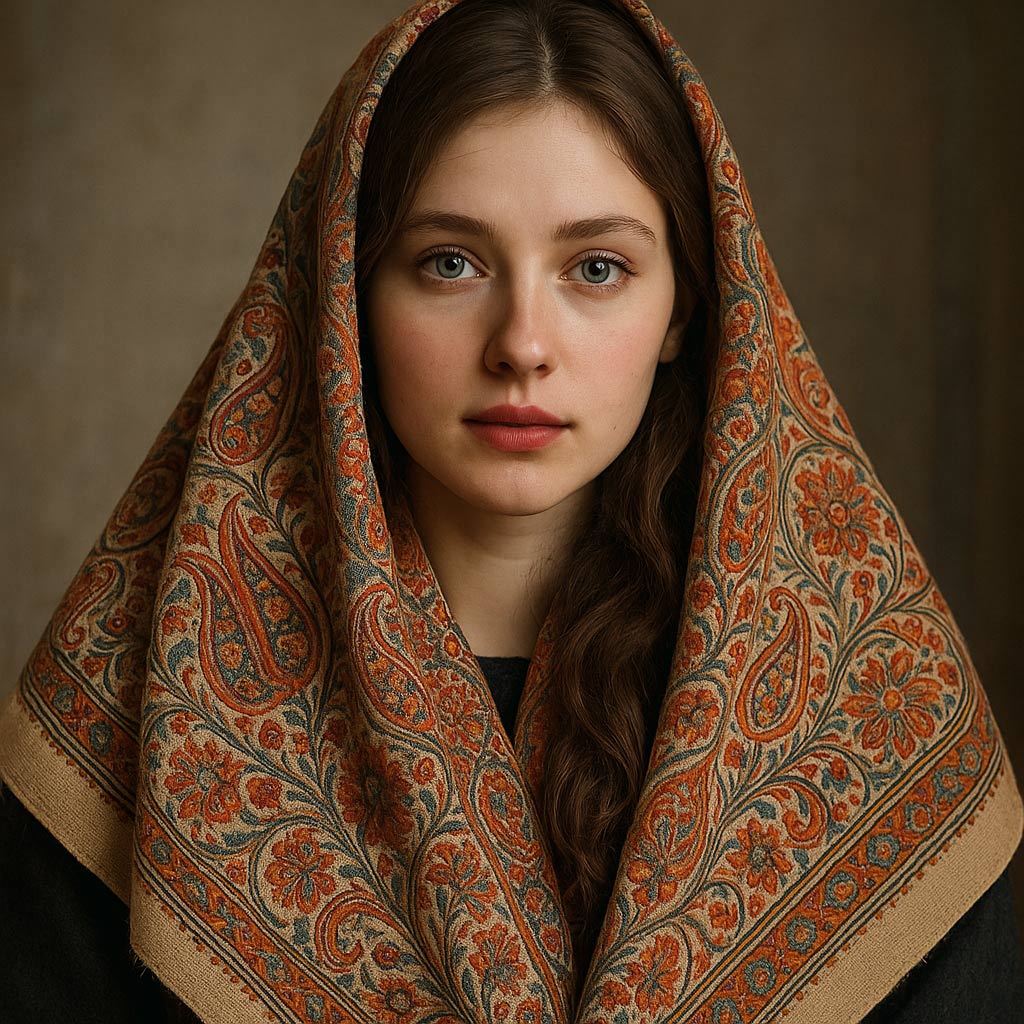
Introduction to Sozni Embroidery
Sozni embroidery is a centuries-old craft from Kashmir, celebrated for its meticulous needlework and luxurious charm. Hailing from the Kashmir Valley in India, this intricate art form transforms textiles into masterpieces through delicate hand-stitching. The word “Sozni” (also spelled Sozani or Suzani) is rooted in the Persian term for “needle,” symbolizing both its Persian influence and its focus on fine craftsmanship. Practiced for over 500 years, Sozni has become a cultural hallmark, once treasured by royalty and now cherished by fashion enthusiasts worldwide. More than mere embellishment, Sozni represents patience, creativity, and deep cultural pride, often gracing the finest Kashmiri pashmina shawls. This embroidery technique is defined by its detailed, precise designs stitched with fine threads on delicate fabrics. A single shawl can take months or even years to finish, depending on the complexity of the pattern. The final product is a stunningly light yet richly adorned fabric that captures the beauty and spirit of Kashmir.
History and Origins of Sozni
The journey of Sozni embroidery is closely tied to Kashmir’s cultural history and Persian influences. Its roots trace back to the 15th century when Persian craftsmen brought their skills to Kashmir. During the reign of Sultan Zain-ul-Abidin, also known as Budshah, the craft flourished. Later, it was enriched by the arrival of Mir Sayyid Ali Hamdani, a Persian Sufi saint, whose followers introduced many arts to the region. Initially a luxury for the elite, Sozni embroidery gained fame during the Mughal era. Emperors like Akbar admired Kashmiri textiles, leading to widespread use of Sozni on royal shawls. By the 18th and 19th centuries, Kashmiri shawls had become coveted exports to Europe, where the paisley pattern—originating from Kashmir—became highly fashionable. Despite the passage of time and political upheavals, Sozni embroidery has endured, passed down through generations of artisans. Today, it enjoys protected status through a Geographical Indication (GI) tag, safeguarding its authenticity and honoring its rich legacy.
Traditional Techniques and Materials Used
Sozni embroidery is celebrated not only for its beauty but also for its extraordinary craftsmanship. Every step of the process is done by hand, demanding skill, precision, and immense patience.
Materials: The base fabric is typically pure pashmina wool, prized for its softness and warmth. Sometimes, other fine wool or silk fabrics are used. Silk or fine cotton threads, dyed in vibrant yet restrained colors, are employed for the embroidery. Traditional Sozni uses a limited palette—usually two or three colors—to highlight the intricacy of the stitches without overwhelming the design.
Pattern Transfer: Designs are initially sketched by master artists and transferred onto the fabric, often through block printing with carved wooden stamps or by hand-drawing.
Stitching Technique: Artisans use fine satin stitches or stem stitches to create extremely detailed motifs. In some pieces, there can be hundreds of stitches per square centimeter, showcasing exceptional precision.
Dorukha (Double-Sided) Embroidery: In Dorukha work, the embroidery is so skillful that the design appears almost identical on both sides of the fabric—a hallmark of excellence.
Tools: Simple pointed needles and embroidery frames are used. Sozni embroidery relies more on the artisan’s hands and skill rather than complex tools.
The combination of soft pashmina and exquisite embroidery creates a lightweight, elegant textile that drapes beautifully and feels almost like a part of the fabric itself.
Patterns, Motifs, and Symbolism in Sozni
Sozni embroidery is rich in symbolic patterns, many inspired by Kashmir’s natural beauty:
- Paisley (Buta) Motifs: These iconic teardrop designs symbolize fertility and eternity and are central to Sozni.
- Flowers and Foliage: Lotus, rose, marigold, and chinar leaves reflect Kashmir’s lush landscape and represent growth and prosperity.
- Geometric Patterns: Symmetrical shapes like diamonds and trellises, influenced by Persian art, symbolize structure and harmony.
- Vines and Creepers: These flowing elements represent continuity and the interconnectedness of life.
- Birds and Nature: Occasionally, birds and small natural emblems appear, symbolizing happiness and nature’s bounty.
Each motif not only beautifies the fabric but also tells a story about the artisan’s environment, culture, and values.
Cultural and Economic Significance of Sozni Embroidery in Kashmir
In Kashmir, Sozni is more than an art form; it’s a living symbol of identity and heritage. Shawls adorned with Sozni are considered heirlooms, gifted at important ceremonies to symbolize respect and honor. The craft is deeply embedded in Kashmiri life, with skills passed down within families.
Economically, Sozni supports thousands of artisans, particularly in rural areas. Kashmiri shawls were historically a major export and continue to attract global buyers today. Initiatives like the GI tag have helped protect artisans from imitation products, while cooperatives and direct marketing efforts have improved artisans’ incomes. Sozni embroidery also serves as a diplomatic gift, showcasing Kashmir’s cultural wealth to the world.
Contemporary Trends: Sozni in Modern Fashion and Décor
While rooted in tradition, Sozni has adapted to modern fashion and décor:
- Expanded Applications: Beyond shawls, Sozni now embellishes saris, scarves, jackets, handbags, and even home décor items like cushions and wall art.
- Designer Collaborations: Fashion designers incorporate Sozni into modern clothing, blending tradition with contemporary style.
- Modern Colors and Motifs: New color palettes and creative motifs appeal to a wider, younger audience without compromising traditional techniques.
- Online and Global Reach: Sozni embroidery is available worldwide through online platforms, helping artisans reach broader markets.
The blend of traditional craftsmanship and modern innovation ensures that Sozni remains a dynamic, evolving art form.
Challenges and Efforts to Preserve the Craft
Despite its beauty, Sozni faces several challenges:
- Mass Production: Machine-made imitations threaten the livelihood of hand embroiderers.
- Economic Hardships: Many artisans struggle financially, discouraging younger generations from learning the craft.
- Sociopolitical Instability: Kashmir’s political unrest and events like the COVID-19 pandemic have disrupted production and sales.
- Aging Artisans: As master craftsmen age, the risk of losing intricate skills grows.
Preservation Efforts Include:
- GI certification to protect authenticity.
- Direct-to-customer sales through craft fairs and cooperatives.
- Government initiatives like the “Craft Safari” that promote artisan workshops.
- Documentation and digital archiving of techniques and motifs.
- Collaborations with contemporary designers to innovate responsibly.
These efforts aim to ensure that Sozni remains a vital and sustainable part of Kashmir’s cultural and economic fabric.
How to Identify Authentic Sozni Work
When buying Sozni embroidery, look for:
- Fine, Slightly Irregular Stitches: Hand embroidery will show slight variations, unlike machine-made pieces.
- Complex Stitches: Genuine Sozni uses satin or stem stitches, not chain stitches.
- Neat Back Side: Authentic pieces have a clean reverse side with minimal loose threads.
- Detailed Motifs: High-quality Sozni features intricate, well-defined designs.
- Dorukha Work: Double-sided embroidery is a hallmark of superior craftsmanship.
- Fabric Feel: Genuine pashmina feels soft, warm, and feather-light.
- Certification: Look for authenticity labels or GI tags.
- Price: True Sozni pieces are labor-intensive and priced accordingly.
Care Tips for Sozni-Embroidered Products
To preserve your Sozni items:
- Cleaning: Dry clean or gently hand wash with mild detergent in cold water.
- Drying: Lay flat to dry; avoid wringing or direct sunlight.
- Ironing: Use low heat with a pressing cloth, preferably iron on the reverse side.
- Storage: Fold neatly, use acid-free tissue, and store in a cool, dry place with moth repellents.
- Handling: Avoid rough surfaces and jewelry that might snag threads.
- Periodic Airing: Air items every few months to prevent musty smells.
- Stain Management: Blot gently and consult professional cleaners for serious stains.
Proper care ensures that your Sozni embroidery remains as stunning as the day it was made, preserving its beauty for generations.


